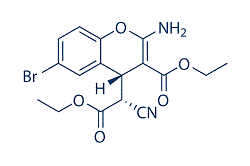| Cas No.: | 65673-63-4 |
| Chemical Name: | (R)-ethyl 2-amino-6-bromo-4-((R)-1-cyano-2-ethoxy-2-oxoethyl)-4H-chromene-3-carboxylate |
| Synonyms: | HA141 |
| SMILES: | NC1=C(C(OCC)=O)C(C(C#N)C(OCC)=O)C2=CC(Br)=CC=C2O1 |
| Formula: | C17H17BrN2O5 |
| M.Wt: | 409.23 |
| Purity: | >98% |
| Sotrage: | 2 years -20°C Powder, 2 weeks 4°C in DMSO, 6 months -80°C in DMSO |
| Description: | HA14-1 is a Bcl-2/Bcl-XL antagonist. HA14-1 binds the designated pocket on Bcl-2 with the IC50 of ≈9 μM in competing with the Bcl-2 binding of Flu-BakBH3, and inhibits its function. |
| Target: | Bcl-2:9 μM (IC50) Bcl-xL |
| In Vivo: | Swiss nude mice are challenged with BeGBM cells (104 injected s.c.). HA14-1 (400 nmol) in 100 μL free RPMI 1640-50% DMSO, or the carrier alone, is given at the site of injection once weekly from day 2 following cell injection. HA14-1 treatment does not have any significant effect on the growth of glioblastoma tumors in immunodeficient mice as monitored twice weekly by measuring the volume of the expanding tumors. Moreover, no gross organ toxicity or weight loss can be detected in mice receiving such treatment. To analyze whether HA14-1 treatment might enhance the efficiency of another antitumoral treatment, Swiss nude mice challenged with human glioblastoma multiforme cells are also given i.p. low doses of Etoposide (2.5 mg/kg in 200 μL of 0.9% NaCl 5 days a week from day 2 following cell injection) together with HA14-1 or mock treatment. Whereas Etoposide treatment is insufficient by itself to restrain the growth of glioblastoma cells, its combination with HA14-1 leads to a significant restrain on tumor growth as judged by the ability of the combined treatment to increase the doubling time of the tumor volume[3]. |
| In Vitro: | HA14-1 is a nonpeptidic ligand of a Bcl-2 surface pocket. HA14-1 induces the activation of Apaf-1 and caspases, possibly by binding to Bcl-2 protein and inhibiting its function. The interaction of HA14-1 with the Bcl-2 surface pocket appeared to be specific for the chemical structure of HA14-1 as a series of synthetic analogs derived from HA14-1 containing various modifications are found to have widely different Bcl-2 binding activities. To examine the effect of HA14-1 on cell viability, HL-60 cells are treated with various concentrations of HA14-1 for 4 h. HA14-1 induces the death of HL-60 cells in a dose-dependent manner. At 50 μM, HA14-1 causes the lost of viability in more than 90% of the cells[1]. HA14-1 is a Bcl-2/Bcl-xL antagonist[2]. |
| Kinase Assay: | The binding affinity of organic compounds to Bcl-2 protein in vitro is determined by a competitive binding assay based on fluorescence polarization. For this assay, 5-carboxyfluorecein is coupled to the N terminus of a peptide, GQVGRQLAIIGDDINR, derived from the BH3 domain of Bak (Flu-BakBH3), which has been shown to bind to the surface pocket of the Bcl-xLprotein with high-affinity (dissociation constant, KD, of ≈0.34 μM). According to our molecular modeling studies and binding measurement using fluorescence polarization, the Flu-BakBH3 peptide binds the surface pocket of Bcl-2 with a similar affinity (dissociation constant, KD, of ≈0.20 μM). Bcl-2 used in this assay is a recombinant GST-fused soluble protein. Flu-BakBH3 and Bcl-2 protein are mixed in the presence or absence of organic compounds under standard buffer conditions and are incubated for 30 min. The binding of Flu-BakBH3 to Bcl-2 protein is measured on a LS-50 luminescence spectrometer equipped with polarizers using a dual path length quartz cell (500 μL). The fluorophore is excited with vertical polarized light at 480 nm (excitation slit width 15 nm), and the polarization value of the emitted light is observed through vertical and horizontal polarizers at 530 nm (emission slit width 15 nm). The binding affinity of each compound for Bcl-2 protein is assessed by determining the ability of different concentrations of the compound to inhibit Flu-BakBH3 binding to Bcl-2[1]. |
| Cell Assay: | The dose-dependent effect of the compounds on the viability of HL-60 cells is tested by using the CellTiter 96AQ kit. In brief, the cell suspension containing 1×105 cells in 100 μL of medium are plated into a 96-well plate and are incubated with compounds (e.g., HA14-1; 10, 20, 30, 40, 50 and 60 μM) at different concentrations. The numbers of apoptotic cells are determined by measuring the optical density on a Wallac Victor counter at 490 nm. Cell viability is also determined by Trypan blue exclusion in a hemocytometer[1]. |
| Animal Administration: | Mice[3] Six- to 7-week-old female Swiss nude mice are maintained under standard conditions for 2 weeks before their s.c. injection with 104 BeGBM cells (resuspended in 100 μL free RPMI 1640) into the hind limbs on day 0. Treatment with HA14-1 is done by injection of 400 nmol HA14-1 in 100 μL free RPMI 1640-50% DMSO at the site of cell injection. Treatment starts at day 2 and is repeated once weekly for the following 4 weeks. Control mice receive equivalent volumes of vehicle (100 μL free RPMI 1640-50% DMSO) with the same frequency. Etoposide treatment is done as follows: either Etoposide (2.5 mg/kg) or sterile physiologic saline is given i.p. to HA14-1- or mock-treated animals on days 2 and 3 followed by five injections per week during the next 4 weeks. Tumor sizes are measured with calipers by the same observer twice weekly. Tumor volumes are calculated. |
| References: | [1]. Wang JL, et al. Structure-based discovery of an organic compound that binds Bcl-2 protein and induces apoptosis of tumor cells. Proc Natl Acad Sci U S A. 2000 Jun 20;97(13):7124-9. [2]. Kessel D, et al. Initiation of apoptosis and autophagy by the Bcl-2 antagonist HA14-1. Cancer Lett. 2007 May 8;249(2):294-9. [3]. Manero F, et al. The small organic compound HA14-1 prevents Bcl-2 interaction with Bax to sensitize malignant glioma cells to induction of cell death. Cancer Res. 2006 Mar 1;66(5):2757-64. |






















